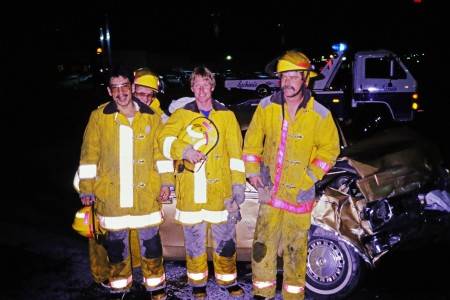ATRIAL FIB WITH RVR/ADULT
INTRODUCTION
This Guideline includes a Special Skill for paramedics specifically trained in use of Diltiazem in symptomatic and unstable patients with atrial fibrillation with a rapid ventricular response (a-fib with RVR). Patients with suspected a-fib with RVR should be assessed for other cardiac narrow complex tachycardias including PSVT and WPW. Symptoms include palpitations which can be distressful, shortness of breath, nausea and vomiting, or chest pain. Signs of instability include atrial fibrillation with a heart rate greater than 150, diaphoresis, altered mental status, chest pain, shortness of breath, cyanosis, or ischemic EKG changes.
GUIDELINE
EMT-B
1. History, primary, and secondary assessments.
2. Vital signs
EMT-I
1. It may be necessary to collect the history and performing the primary and secondary exams.
2. Establish peripheral IV. It is unusual that an IO is needed but clinical judgement will dictate this in severely unstable patients.
EMT-P
1. Review or obtain history including history of cardiac disease, atrial fibrillation, Wolf-Parkinson-White (WPW) syndrome, PSVT, myocardial infarction, stents, angina, and prior episodes of RVR.
2. Focused physical examination
3. 12-lead EKG
4. Criteria for consideration of DILTIAZEM
a. No history of WPW.
b. QRS less than or equal to 120 msec.
c. Blood pressure systolic greater than 90. Remember in older adults with hypertension systolic pressures of 90 may be low and DILTIAZEM safer the higher the blood pressure
d. HR greater than or equal to 150
5. Asymptomatic and stable
a. Reassure, reassess, and monitor
6. Symptomatic with any signs of instability
a. DILTIAZEM 0.25 mg./kg. administered IV/IO over 5 minutes. May repeat in 15 minutes if needed.
7. Unstable
a. DILTIAZEM 0.25 mg./kg. IV/IO over 5 minutes. May repeat in 15 minutes if needed.
b. If unstable but not a candidate for DILTIAZEM consider synchronized cardioversion.
8. SPECIAL NOTE FOR PATIENTS 65 AND OLDER
a. The maximum initial dose of DILTIAZEM should not exceed 10 mg. The maximum repeat dose should not exceed 20 mg.
9. Management of Adverse Events
a. Hypotension: Usually transient but may require fluid bolus.
b. Bradycardia: Usually transient but if combined with hypotension and evidence of worsening perfusion consider CALCIUM CHLORIDE 5-10 ml. IV slowly administered.
c. Adverse events are most common in older patients with blood pressures less than 140 systolic and heart rates below the criteria listed in this protocol.
d. Heart blocks are rare but a serious adverse reaction and the infusion should be stopped and CALCIUM considered.
e. NITROGLYCERIN produces much higher adverse events and shouldn’t be combined with DILTIAZEM.
10. Note on mixing the drug. There are THREE tabs that must be manipulated or opened.
a. The bottle tab holding the DILTIAZEM.
b. The cap on the fluid bag.
c. There is a tab inside the fluid bag that must be opened to mix the drug.
INTRODUCTION
This Guideline includes a Special Skill for paramedics specifically trained in use of Diltiazem in symptomatic and unstable patients with atrial fibrillation with a rapid ventricular response (a-fib with RVR). Patients with suspected a-fib with RVR should be assessed for other cardiac narrow complex tachycardias including PSVT and WPW. Symptoms include palpitations which can be distressful, shortness of breath, nausea and vomiting, or chest pain. Signs of instability include atrial fibrillation with a heart rate greater than 150, diaphoresis, altered mental status, chest pain, shortness of breath, cyanosis, or ischemic EKG changes.
GUIDELINE
EMT-B
1. History, primary, and secondary assessments.
2. Vital signs
EMT-I
1. It may be necessary to collect the history and performing the primary and secondary exams.
2. Establish peripheral IV. It is unusual that an IO is needed but clinical judgement will dictate this in severely unstable patients.
EMT-P
1. Review or obtain history including history of cardiac disease, atrial fibrillation, Wolf-Parkinson-White (WPW) syndrome, PSVT, myocardial infarction, stents, angina, and prior episodes of RVR.
2. Focused physical examination
3. 12-lead EKG
4. Criteria for consideration of DILTIAZEM
a. No history of WPW.
b. QRS less than or equal to 120 msec.
c. Blood pressure systolic greater than 90. Remember in older adults with hypertension systolic pressures of 90 may be low and DILTIAZEM safer the higher the blood pressure
d. HR greater than or equal to 150
5. Asymptomatic and stable
a. Reassure, reassess, and monitor
6. Symptomatic with any signs of instability
a. DILTIAZEM 0.25 mg./kg. administered IV/IO over 5 minutes. May repeat in 15 minutes if needed.
7. Unstable
a. DILTIAZEM 0.25 mg./kg. IV/IO over 5 minutes. May repeat in 15 minutes if needed.
b. If unstable but not a candidate for DILTIAZEM consider synchronized cardioversion.
8. SPECIAL NOTE FOR PATIENTS 65 AND OLDER
a. The maximum initial dose of DILTIAZEM should not exceed 10 mg. The maximum repeat dose should not exceed 20 mg.
9. Management of Adverse Events
a. Hypotension: Usually transient but may require fluid bolus.
b. Bradycardia: Usually transient but if combined with hypotension and evidence of worsening perfusion consider CALCIUM CHLORIDE 5-10 ml. IV slowly administered.
c. Adverse events are most common in older patients with blood pressures less than 140 systolic and heart rates below the criteria listed in this protocol.
d. Heart blocks are rare but a serious adverse reaction and the infusion should be stopped and CALCIUM considered.
e. NITROGLYCERIN produces much higher adverse events and shouldn’t be combined with DILTIAZEM.
10. Note on mixing the drug. There are THREE tabs that must be manipulated or opened.
a. The bottle tab holding the DILTIAZEM.
b. The cap on the fluid bag.
c. There is a tab inside the fluid bag that must be opened to mix the drug.
